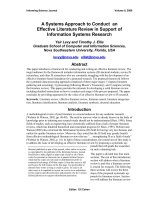Lecture A systems approach to small group interaction (8/e): Chapter 4 - Stewart L. Tubbs
Bạn đang xem bản rút gọn của tài liệu. Xem và tải ngay bản đầy đủ của tài liệu tại đây (688.56 KB, 32 trang )
CCHH AAPP TT EE RR
4
Group Circumstances and
Structure
Stewart L. Tubbs
McGrawHill
© 2004 The McGrawHill Companies, Inc. All rights reserved.
Slide 2
Group Circumstances and
Structure
•
•
•
•
•
•
McGrawHill
Glossary
Case Study
Physical Environment
Group Size and Structure
Type of Groups
The Systems Approach
© 2004 The McGrawHill Companies, Inc. All rights reserved.
Slide 3
Glossary
• Casual and Social Groups—include neighborhood
groups, fraternities, and even classmates. The impact of
these relationships on behavior is often quite profound.
• Communication Networks—the five patterns of
communicating between group members.
• Education Groups—groups that interact for the sole
purpose of study or instruction.
• Primary Groups—groups that usually include one’s
family and closest friends.
• ProblemSolving Groups—groups that form in
order to solve one or more problems.
McGrawHill
© 2004 The McGrawHill Companies, Inc. All rights reserved.
Slide 4
Glossary
• Seating Patterns—often affect the type and volume of
interaction in a group.
• Territoriality—the word was coined by Edward Hall
and is defined as “the tendency for humans and other
animals to lay claim to and defend a particular area or
territory.”
• Work Groups—the formations of people on the job.
McGrawHill
© 2004 The McGrawHill Companies, Inc. All rights reserved.
Slide 5
Case Study
Chempure Pharmaceutical Company (A)
1. What are your impressions of the processes used to
develop new medicines?
2. What do you think of the testing of chemicals on
animals?
3. Are there any ways you could suggest to improve the
use of teams in the drug development process?
McGrawHill
© 2004 The McGrawHill Companies, Inc. All rights reserved.
Slide 6
Case Study
Chempure Pharmaceutical Company (B)
1. How would you resolve the problem now facing the
physician leading the project?
2. What future problems do you anticipate? How would
you address them?
3. What practical lessons from this case apply to your life?
McGrawHill
© 2004 The McGrawHill Companies, Inc. All rights reserved.
Slide 7
Case Study
Chempure Pharmaceutical Company (C)
1. What do you think about how conflicts at Chempure are
resolved?
2. What, if anything, would you recommend that
Chempure do differently?
3. What other implications or lessons does this case
present that apply to your life?
4. How does this case illustrate the Tubbs Model of Small
Group Interaction?
McGrawHill
© 2004 The McGrawHill Companies, Inc. All rights reserved.
Slide 8
Physical Environment
• An environment that is conducive to more
communication, such as the less traditional
“open office,” is often more conducive to
the success of group tasks.
• Territoriality
– In addition to identifying certain places as our
territory, we also move about in a portable space
bubble of about 18 inches in each direction that
we let only certain people violate.
• This is referred to as our personal space.
McGrawHill
© 2004 The McGrawHill Companies, Inc. All rights reserved.
Slide 9
Physical Environment
• Territoriality (continued)
– Intimate distance extends from touching to
about 18 inches.
– Personal distance ranges from 18 inches to
about 4 feet.
– Social distance refers to the distance between 4
to 12 feet.
– Public distance refers to 12 feet and beyond.
McGrawHill
© 2004 The McGrawHill Companies, Inc. All rights reserved.
Slide 10
Physical Environment
• Seating Patterns
– Research has shown that even the seating
patterns around rectangular tables have a major
impact on interaction.
McGrawHill
© 2004 The McGrawHill Companies, Inc. All rights reserved.
Slide 11
Physical Environment
• Seating Pattern
McGrawHill
© 2004 The McGrawHill Companies, Inc. All rights reserved.
Slide 12
Physical Environment
• Seating Patterns at Rectangular Tables:
(a) CornertoCorner, (b) FacetoFace,
(c) DistantOpposite, (d) Corner to End,
(e) SidebySide, and (f) EndtoEnd.
McGrawHill
© 2004 The McGrawHill Companies, Inc. All rights reserved.
Slide 13
Physical Environment
• Seating Preferences at Round Tables:
(a) SidebySide, (b) DistanceOpposite,
and (c) SidetoEnd.
McGrawHill
© 2004 The McGrawHill Companies, Inc. All rights reserved.
Slide 14
Group Size and Structure
• Communication Networks
– Centralized networks, such as the chain and the
wheel, are better for solving simple problems.
– When the problem is complex, the decentralized
networks, such as the circle and the allchannel
are faster and more accurate and result in higher
member satisfaction.
McGrawHill
© 2004 The McGrawHill Companies, Inc. All rights reserved.
Slide 15
Group Size and Structure
• Communications Networks: (a) Wheel,
(b) Chain, (c) Y, (d) Circle, and
(e) AllChannel.
McGrawHill
© 2004 The McGrawHill Companies, Inc. All rights reserved.
Slide 16
Group Size and Structure
• Group Size
– As the group’s size increases arithmetically
(linearly), the potential number of interactions
increases geometrically (exponentially).
– Social loafing, the decreased effort of each
individual member in the group, occurs more as
the number of people in a group increases.
McGrawHill
© 2004 The McGrawHill Companies, Inc. All rights reserved.
Slide 17
Group Size and Structure
• Group Size
– Forsyth (1999) suggest the following guidelines
to minimize social loafing:
1. Increase personal involvement.
2. Minimize free riding.
3. Clarify group goals.
4. Set high standards.
5. Increase collective efficacy.
6. Increase unity.
McGrawHill
© 2004 The McGrawHill Companies, Inc. All rights reserved.
Slide 18
Types of Groups
•
•
•
•
•
McGrawHill
Primary Groups
Casual and Social Groups
Educational Groups
Work Groups
ProblemSolving Groups
© 2004 The McGrawHill Companies, Inc. All rights reserved.
Slide 19
Types of Groups
• Work Groups
– The level of productivity is set by group norms,
not by physiologic capacities.
– Noneconomic rewards and sanctions
significantly affect the behavior of the workers
and largely limit the effect of economic
incentive plans.
– Often workers do not act or react as individuals
but as members of groups.
• A recent innovation in work groups is the self
directed work team (SDWT).
McGrawHill
© 2004 The McGrawHill Companies, Inc. All rights reserved.
Slide 20
Types of Groups
• ProblemSolving Groups
– The terms taskoriented, problemsolving, and
decisionmaking groups have been used
interchangeably to stress the emphasis on the
cognitive end products of group discussion.
– One recent innovation is the use of tiger teams
—small groups of highperforming people who
are challenged by a company’s executive team
to take problems and find workable solutions.
McGrawHill
© 2004 The McGrawHill Companies, Inc. All rights reserved.
Slide 21
Types of Groups
• ProblemSolving Groups
– Types of Discussion Questions
• An effective problemsolving discussion begins with
an effectively structured discussion question.
• A topic should be limited to one issue.
–
–
–
–
McGrawHill
Questions of fact
Questions of definition
Questions of value
Questions of policy
© 2004 The McGrawHill Companies, Inc. All rights reserved.
Slide 22
Types of Groups
• ProblemSolving Groups
– Discussion Group Formats
• Dialogue—a discussion or conversation between two
people.
• Panel—usually involves a small number of people
conducting an informal discussion on a topic that
they have all thought about and possibly researched
beforehand.
• Symposium—includes several participants, each of
whom gives a short formal presentation on a
prepared topic.
McGrawHill
© 2004 The McGrawHill Companies, Inc. All rights reserved.
Slide 23
Types of Groups
• ProblemSolving Groups
– Discussion Group Formats . . . (continued)
• Forum—a questionandanswer period designed to
allow audience members to interact with the
discussion group.
• Colloquy—involves questioning of experts by the
other experts on the panel, laypersons on a second
panel, or laypersons in the audience.
McGrawHill
© 2004 The McGrawHill Companies, Inc. All rights reserved.
Slide 24
Types of Groups
• Discussion Group Techniques
– Phillips 66
• A specific technique developed by J. D. Phillips, it
allows all members of an audience to form groups of
about six people to discuss a specific topic for about
six minutes and then report the group’s conclusion
through a spokesperson.
– Case discussion
• An educational discussion centered on a real or
hypothetical event.
McGrawHill
© 2004 The McGrawHill Companies, Inc. All rights reserved.
Slide 25
Types of Groups
• Discussion Group Techniques (continued)
– Role playing
• Allows participants to adopt a new “role” or set of
behaviors.
– Fishbowl
• One small group attempts to solve a problem for a
specified period of time (e.g., 30 minutes), while a
second group, seated around the outside of the first
group, observes the process.
– Conference
• A series of meetings on topics of common interest
between and among people who represent different
groups.
McGrawHill
© 2004 The McGrawHill Companies, Inc. All rights reserved.









